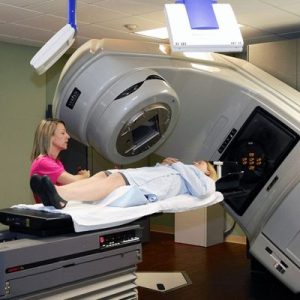
Radiotherapy in Breast Cancer: What You Need to Know
The radiotherapy for breast cancer is a local therapeutic approach, which uses high-energy radiation to destroy any cancer cells that may be left behind after surgery.
When is radiotherapy used?
The breast radiotherapy mainly granted:
- After breast-conserving surgery (lumpectomy), to reduce the risk of recurrence.
- In selected cases following mastectomywhen high-risk features are present (e.g., large tumor, lymph node involvement).
- In metastatic cases, to relieve symptoms or slow disease progression.
Typically, radiotherapy begins about 4–6 weeks after surgery or after completing chemotherapy, if given beforehand.
Which areas are irradiated?
Depending on the case, radiation may target:
- The entire breast or the mastectomy site
- The lumpectomy site with an additional “boost” dose
- The axillary (armpit) region or supraclavicular area if lymph nodes are involved
What is the procedure like?
The most common form is external beam radiation therapy, in which a special device sends radiation precisely to a specific area of the body. The radiation itself is painless and lasts a few minutes, but the daily session requires time for preparation, targeting, and control.
Total treatment duration usually lasts 5 to 7 weeks (5 days a week). Hypofractionated schedules, with larger daily doses over 3–4 weeks, are increasingly used and have comparable effectiveness.
An alternative is brachytherapy, where small radioactive sources are temporarily placed inside the lumpectomy cavity, mainly for selected early-stage cases.
What are the side effects?
Common side effects are mainly local and include:
- Redness, swelling and change in skin color in the area
- Burning sensation or tenderness
- Fatigue (especially towards the end of treatment)
These effects typically resolve within 6 to 12 months.
Long-term possible effects include:
- Lymphedema (swelling of the arm due to lymph fluid buildup)
- Tissue fibrosis, reduced mobility, or breastfeeding difficulties
- Rarely, cardiopulmonary complications, particularly when irradiating the left breast (modern techniques have greatly reduced this risk)
The frequency and severity of side effects depend on many factors, including the type of surgery, radiotherapy technique, and individual patient characteristics.
In summary, Radiotherapy is a crucial part of breast cancer treatment that significantly reduces recurrence and improves survival. The appropriate regimen is chosen in collaboration with your oncology team, tailored to the disease specifics and your individual needs.
The breastaware.gr you’ll find reliable, clear information about breast health, practical advice, and the latest scientific updates on prevention, diagnosis, and treatment of breast diseases.
Sources::
- National Comprehensive Cancer Network (NCCN) Guidelines for Breast Cancer
- European Society for Medical Oncology (ESMO) Clinical Practice Guidelines
- American Cancer Society: Radiation Therapy for Breast Cancer
